Online Quiz
Pressure & Winds
AIR PRESSURE
Is the Force exerted against a surface by the continuous collision of gas molecules
Is the P exerted by the weight of the air above
The Ρ differences causes the air to move from higher Ρ toward a region of lower Ρ
Pressure Units
At sea level:
1 atmosphere (atm)
14.7 pounds/inch² (p/in²)
101,325 Newton/m² (N/m²)
101,325 Bascal (Pa)
1013.25 millibars (mb)
29.92 inch of mercury (inHg)
760 millimeter of mercury (mmHg)
76 cm of mercury (cmHg)
760 torr
SI unit is the pascal
1 mb = 100 N/m² (Meteorologists use thies)
1 mb = 100 Pa
Bascal (Pa) is the force (1N) acting on a unit aria (1m²)
DAILY P VARIATIONS
The largest P difference, about 2.5mb, occurs near the equator
daily (diurnal) fluctuation of P are due to the absorption of solar energy by O₃ in upper atm & H₂O in lower atm
thermal tides (or atmospheric tides): The warming & cooling of the air creates density oscillations, that show up as small pressure changes near the earth’s surface
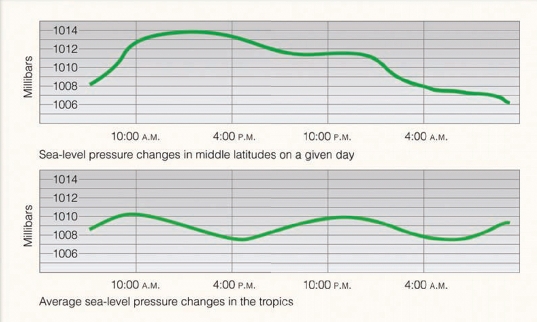
Measuring Pressure
Barometer Fluid Filled, liquid mercury
Aneroid barometer No fluid, Aneroid cell
Recording Barograph An aneroid barometer, records a P over time
Why is mercury rather than water used in the barometer? convenience
– Mercury seldom rises to > 80 cm
– A water is 13.6 times less dense than Hg, an atm P of 76 cmHg, would be equivalent to 1034 cmH₂O
– A water barometer resting on the ground near sea level would have to be read from a ladder over 10 m tall
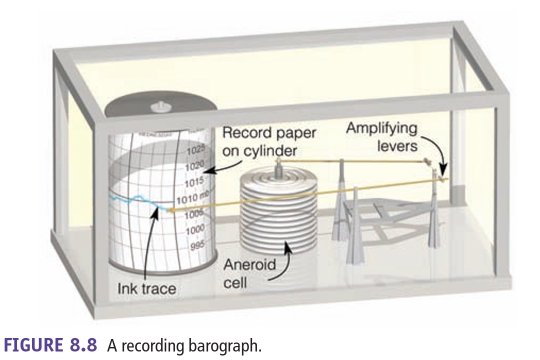

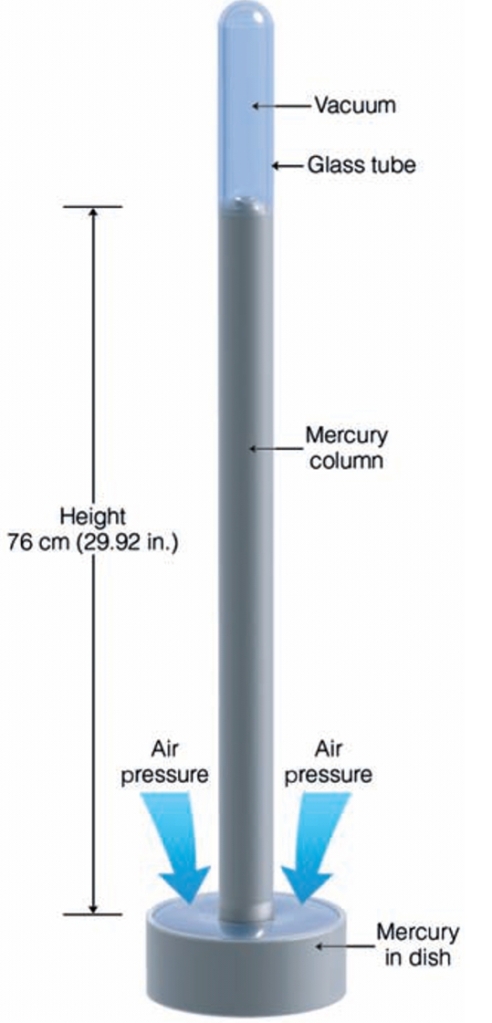
Influence of Τ & Water Vapor
Warm Air Faster molecules, less dense, low P
Cold Air Slower molecules, denser, high P
Add H₂O makes air lighter (less Dense):
Cold, & dry → Higher P, Higher ρ
Warm, & dry → low P than Cold, dry
Cold, & humid → less than warm & dry
Warm, & humid → Lowest P, & lowest ρ
cold,dry> warm,dry> cold,wet> warm,wet

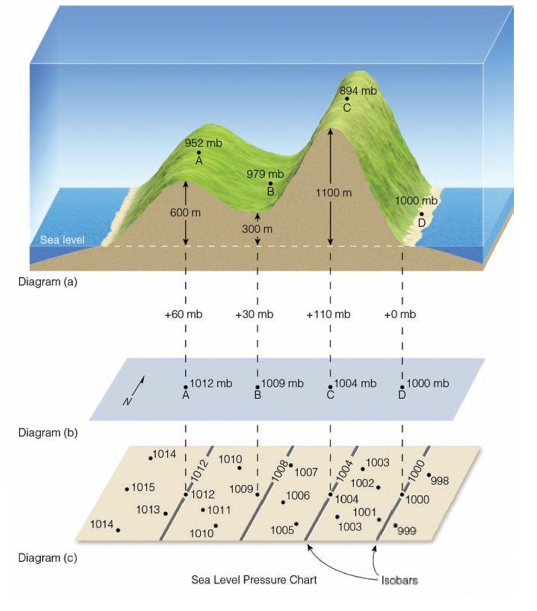
Contours lines or curves of constant P
They are corrected for altitude to equivalent Sea Level Pressure (SLP)
Pressure & Wind
Wind is nature’s attempt at balancing inequalities in pressure
– Unequal heating generates inequalities in P
Winds flow from high to low pressure
Wind caused by
→ Solar radiation (SR) is the source of energy
→ SR causing differences in heating (O₃ absorb it in upper atm, & H₂O in lawer)
→ Unequal heating causes horizontal differences in pressure HDP
→ HDP cause PGF (causes wind to start move)
→ the wind flow from region of high P to regions of low P under PGF due to HDP
Main forces that affect wind
1. Pressure Gradient Force (PGF)
2. Coriolis Force (rotation of the Earth)
3. Centripetal force
4. Friction
5. Gravity
2 forces cause wind speed & direction to be different than predicted by the PGF
1. Coriolis (rotation of the Earth)
2. Friction
Wind flow in a straight line from high to low P If Earth didn’t rotate & there was no friction
Winds flow from High to Low P if affected by HPD that caused PGF
The gas law: P α (ρ x Τ)
PV = nRT → P = (mRT)/VMw
P = (ρRT)/Mw → P α (ρ x Τ)
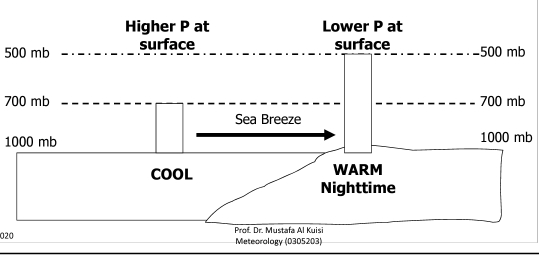
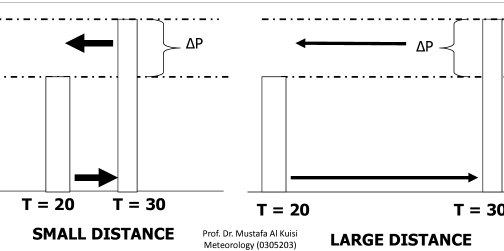
Change in P over small distance = large PGF
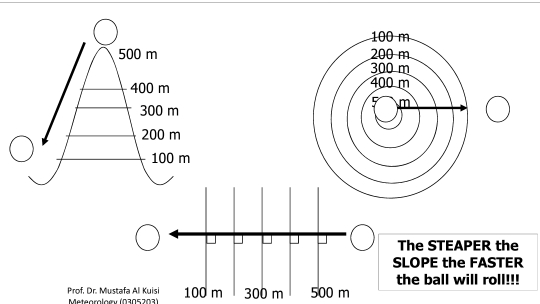
PGF is at right angles to isobars
PGF STRONGER if isobars are closer together
When given P Heights, the PGF points from regions of High P to that of Low P
If all we had was the PGF, wind would act like a Ball rolling down a slope… rolling at 90° to the slope!

Coriolis Force Fc
Results from the rotation of the Earth
– Earth rotates 15°/hr
Causes PGF to cross isobars not at right θ
– Winds curve to the RIGHT in the NH
– Winds curve to the LEFT in the SH
Affects wind direction, not speed
Affected by (factors determine the magnitude of the Coriolis Force)
1. wind speed
– Stronger wind → greater force
2. latitude dependent
– Strongest at the poles
– nonexistent at the equator
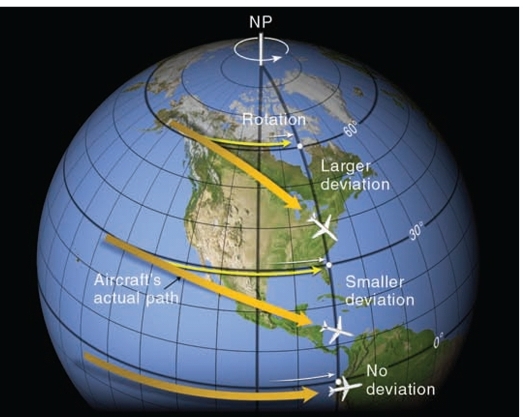
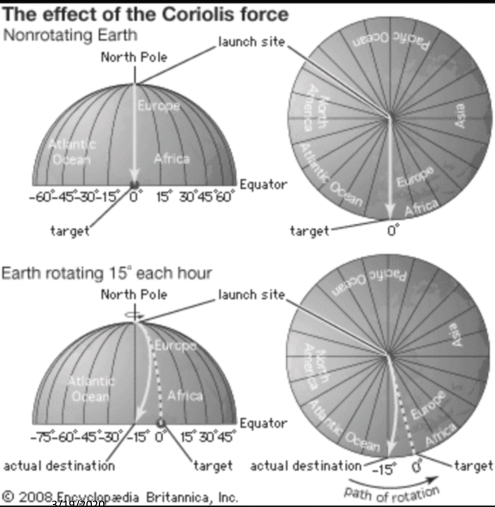
Even though the rock travels in STRAIGHT line, when we plot it’s path on the surface it follows a path that CURVES to the RIGHT!
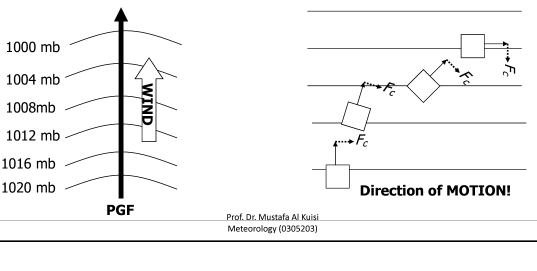

– only the PGF & Fc affect an air parcel
– air parcel is at equilibrium, if PGF & Fc opposite in direction
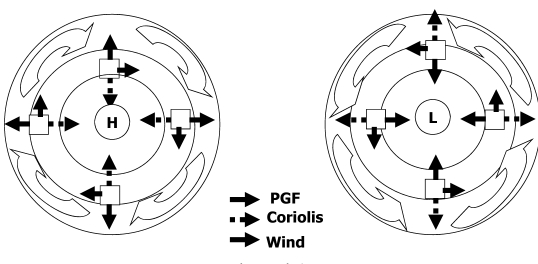
Speed of the wind depends on how close is the isobars are
Friction
Applied to wind within 1 to 1.5 km of the surface
direction of Friction
– direction always opposite of motion
– direction towards of the PGF
– direction of the low P
– direction opposite of the Fc
affects air at the surface more than air aloft (decreases with hight)

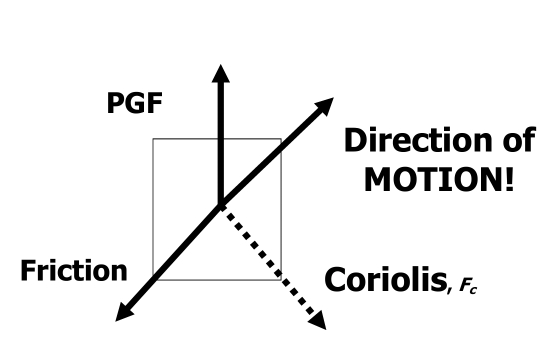
Geostrophic Flow & Friction together causes parcel to slow down
Fc decreases in strength

Vertical Motion & Pressure
Movement of air can cause variations in P
Net flow of air into a region = CONVERGENCE
Net flow of air out of a region = DIVERGENCE

Law: cyclonic convergent, counterclockwise
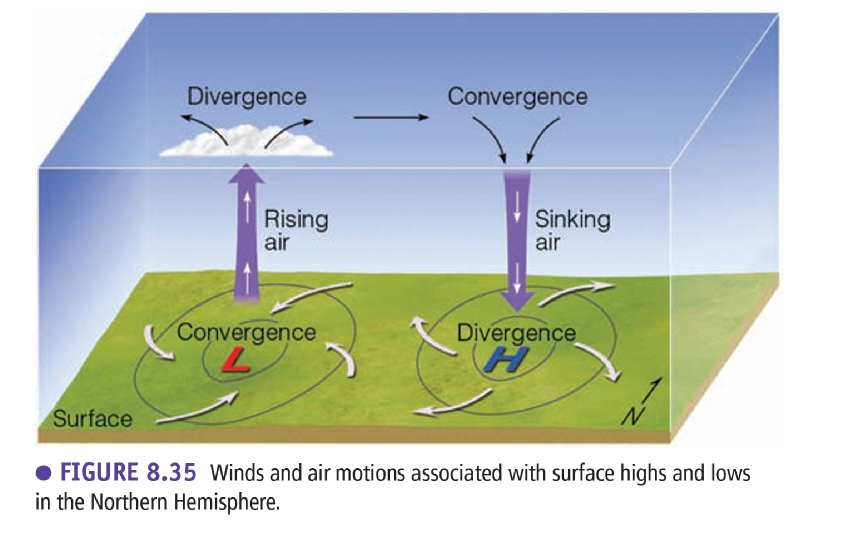
Factors that promote vertical air flow
Friction can cause convergence & divergence
ocean vs land as air move
– from ocean to the land wind slows down
– from land to ocean → divergence & subsidence
Stream
– as air move upstream →convergence
– as air move downstream →divergence
Mountains hinder the flow of air
– As air passes over it → divergence aloft
– After going over → horizontal convergence
Prevailing Winds
Name given to the wind direction
– observed during a give time period
– Can affect the climate of a region
– Helpful for city planning

Diagram that represents the percentage of time the wind blows from different direction
The End
